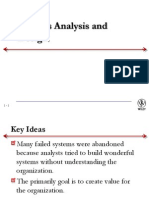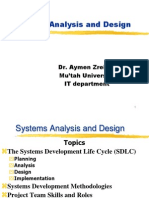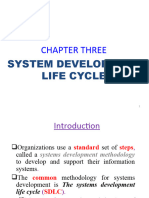0% found this document useful (0 votes)
7 views44 pagesLecture 01 Introduction and SDLC
The document outlines the importance of Systems Analysis and Design (SAD) in managing information systems, highlighting the high failure rates of IT projects and the need for accurate requirements analysis. It details the Systems Development Life Cycle (SDLC) phases: Planning, Analysis, Design, and Implementation, along with various methodologies such as Waterfall, Rapid Application Development, and Agile Development. Key roles in project teams are also identified, emphasizing the collaborative effort required to successfully deliver information systems that meet user needs.
Uploaded by
Tanjim MostafaCopyright
© © All Rights Reserved
We take content rights seriously. If you suspect this is your content, claim it here.
Available Formats
Download as PPT, PDF, TXT or read online on Scribd
0% found this document useful (0 votes)
7 views44 pagesLecture 01 Introduction and SDLC
The document outlines the importance of Systems Analysis and Design (SAD) in managing information systems, highlighting the high failure rates of IT projects and the need for accurate requirements analysis. It details the Systems Development Life Cycle (SDLC) phases: Planning, Analysis, Design, and Implementation, along with various methodologies such as Waterfall, Rapid Application Development, and Agile Development. Key roles in project teams are also identified, emphasizing the collaborative effort required to successfully deliver information systems that meet user needs.
Uploaded by
Tanjim MostafaCopyright
© © All Rights Reserved
We take content rights seriously. If you suspect this is your content, claim it here.
Available Formats
Download as PPT, PDF, TXT or read online on Scribd
/ 44
















































































































